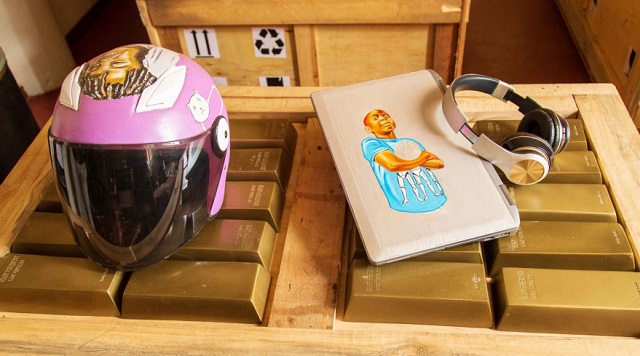
Aloka creates figurative paintings that invite interrogation on the controversial subject of Africa’s skilled lobour export to the developed world
Kampala, Uganda | DOMINIC MUWANGUZI | With Brain drain as a modern day trend that is widely blamed for robbing the African continent of its skilled professional labour, especially the younger generation, there’re little interventions being made to curtail the wave. Here, artist Aloka Trevor, a Ugandan artist based in Kampala creates a body of work that draw the public’s attention to this endemic problem. Through creating figurative paintings that familiarize the concept of labour export, the artist constructs deeper conversations on the often controversial topic. The notion of interrogating the subject is evocative of the artist’s fervent Pan African sentiments that inspire his apprehension towards western dominance and influence on the Continent.
Aloka’s earlier three dimensional work , still on the same subject, that featured in KLA ART 021 included painting of children faces inside the installation, This experimental technique served the purpose of ‘evoking a humanity that is often invisible in the transaction of the labour market to the viewer’, according to the curatorial note produced by organizers of the festival. As such, the installation inform of a trade clearance area with everyday objects like jute sacks, gold bars (wood sprayed on with gold enamel), cooking gas cookers and gloves, drew immediate attention to the public and invited a myriad of conversations on the topic.
Presently the artist has made a shift from installation to painting on canvas to enable further experimentation and consequently provide palatable appreciation of his work to larger audiences.The artist therefore uses a variety of motifs to create a more engaging visual language for his series. Within this framework, Aloka selectively chooses his palette of gold or copper on his selected subjects to underscore the message in the painting. Here he is implicitly conveying the value of the skilled labour force identified in nurses, artists or fashion designers to the viewer.
According to the artist, he says,“ The value of a skilled professional can be easily appreciated by the public through minerals which we obviously have in Uganda.” On the other hand, the recurrent use of a bright palette is not only credited for its injection of an aesthetic appeal into the painting and therefore it become visually attractive to the viewer, but imbues an attention for detail. The latter quality is significantly ushered into the painting by the subtle but harmonious application of paint on canvas, and the delicate balance between colour and other elements composed therein the painting.
 It would be plausible to guess that the artist’s deliberate choice of imagery and motifs is a representation of his social intelligence. While he confesses a deeper connection and love for his African identity, he incidentally seems to be fully aware of his apparent position in this globalized world that assumes that we are all global citizens. The globalized world also with its attributes of a generally liberalized economy, equally promotes the idea of skilled labour export within a free market economy setting. Therefore, Aloka doesn’t emerge as an angry propagandist attempting to over run established establishments or systems. He otherwise confronts such complex realities delicately; carefully balancing the need to preserve and cherish his identity with what he perceives as an already existing social-economic disaster that is depleting the continent of its powerful human resource. This clever approach make his work open to audiences beyond the boundaries of the continent.
It would be plausible to guess that the artist’s deliberate choice of imagery and motifs is a representation of his social intelligence. While he confesses a deeper connection and love for his African identity, he incidentally seems to be fully aware of his apparent position in this globalized world that assumes that we are all global citizens. The globalized world also with its attributes of a generally liberalized economy, equally promotes the idea of skilled labour export within a free market economy setting. Therefore, Aloka doesn’t emerge as an angry propagandist attempting to over run established establishments or systems. He otherwise confronts such complex realities delicately; carefully balancing the need to preserve and cherish his identity with what he perceives as an already existing social-economic disaster that is depleting the continent of its powerful human resource. This clever approach make his work open to audiences beyond the boundaries of the continent.
Ready for Export is afigurative representation of what is happening in the artist’s immediate surrounding. The artistic ploy to integrate people who’re close to him in the painting, doesn’t only critically provide individuality in the artwork, but create emotional overtones in the work. It therefore acquires value in the artist’s eyes and similarly in the eyes of the public. The artist also further explains that the technique fosters the idea of clarity in the work.
In the midst of such studio dexterity, the youthful artist from a simple background is quietly preoccupied with the question of Who AM I. The question is contextualized within Africa and the people who subscribe to itsidentity. Aloka an artist who lives and works on the African continent, seemingly is uncomfortable with the continuous pursuit for validation from the West as expressed by the ongoing brain drain onslaught happening everywhere on the continent.
Does such search for acceptance, often accompanied by compromise on what we believe in, reflect Africa’s worth and independence; first individually for himself as an artist and then secondly for Africans that inhabit the continent? In trying to answer these questions, the artist a former mechanic apprentice, picks up a brush and paint to pursue his personal reflection on the subject and also elicit the audience’s attention on the topic. Perhaps a conversation with them through his strong visual language can attempt to provide answers or maybe not.
****
The artist describes himself as a progressive artist instead of the definition of self –taught artist.
 The Independent Uganda: You get the Truth we Pay the Price
The Independent Uganda: You get the Truth we Pay the Price



